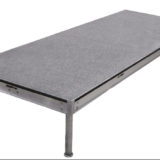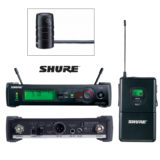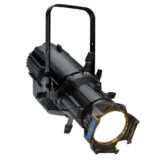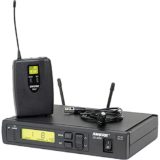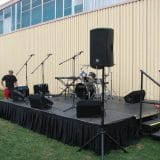Signal flow is one of the most fundamental aspects of audio equipment. It is absolutely essential to be aware of the concepts discuss below if you want to understand how to work with audio equipment or systems, even at a the most novice level.
The Basics:
An audio signal acts like a stream of water that is in constant flow and travels via pipes (cables) and faucets (amps, mixers, compressors) on its way to the speakers and ultimately your ears. All equipment in audio has an input and an output, allowing the audio flow to travel from one piece of equipment to the next.
Setup:
Here is an example a basic signal flow setup. A person speaks words into a microphone on a stage. One end of a cable is plugged into the microphone, and the other end is plugged into the mixing console and pre-amps. More cables connect the mixer and pre-amps to the venue speakers. Now look at how signal flow is applied to this setup.
The person on the stage creates the initial signal or input. The microphone converts his acoustical energy into electrical energy and the signal is outputted into the microphone cable. The signal flows through the cable to the mixing console.
Mixer:
When the signal flow reaches the mixing console, it flows in the way the manufacturer designed the mixing console. Every console model is different, and the signal flow might vary between different manufacturers. It is a good idea to consult the owner’s manual to get the best idea of the internal workings of the mixing console. Most include diagrams detailing the the signal flow through the console.
The audio signal is sent to one of the mixing console’s channels, adjusted to the correct level by means of the channel fader, and is then outputted into the next cable. The audio signal flows to the inputs of the pre-amps which increase the signal. The audio then flows from the pre-amps, through the speaker cable, and then to the inputs of the speakers. The speakers turn the electrical energy back into acoustical energy that can be interpreted by the human ear. The journey of the audio signal is thus complete.
Why Should I Care?
How does knowing this concept give you an advantage? Knowing the concepts behind signal flow allows to set up and break down a system quickly and correctly. The main takeaway is that every piece of equipment in the audio signal flow has an input and an output.
Where is the audio signal coming from and where is it going? This is the fundamental question is setting up audio systems.
Understanding signal flow also allows you to troubleshoot more quickly and effectively.
“Leaks” are a signal flow issue to look for if you’re experiencing problems. Are you getting signals from other microphones but not the one for the guitar amplifier? Check each part of the signal flow and by process of elimination work your way to the possible leak. Maybe there’s a loose cable in the signal flow or a signal receiver was mistakenly turned off.
You’ll be happy you know the basics of signal flow when disaster strikes five minutes before an event is scheduled to begin.

